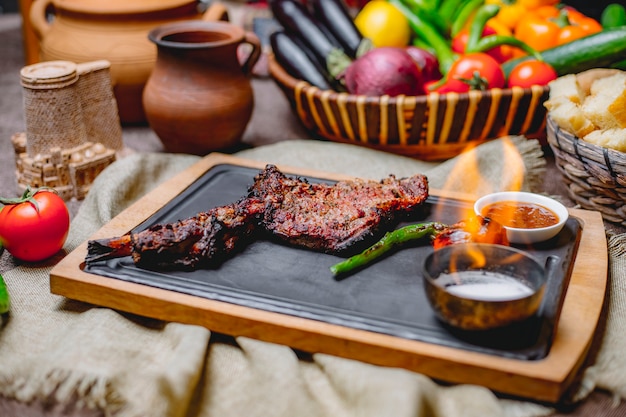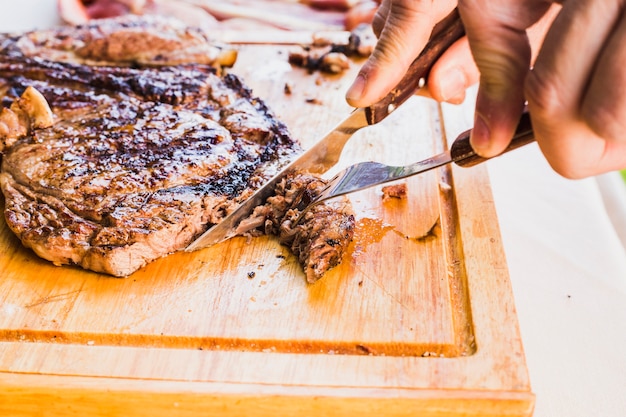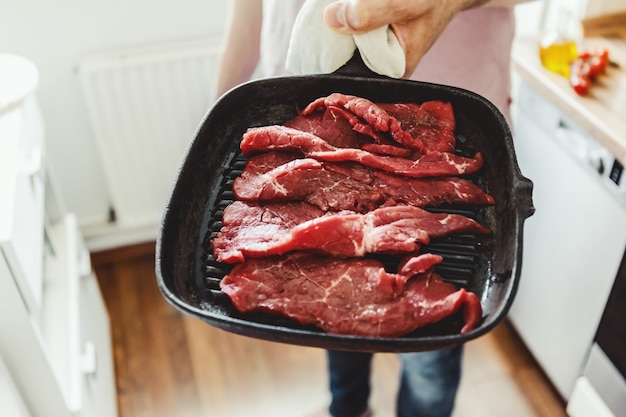You’re ready to impress, aren't you? A perfectly cooked ribeye steak, seared to a golden brown, juicy and pink inside? It's a dish that screams "I know what I'm doing!" For years, I thought you needed a fancy grill or a special griddle, but let me tell you, a good old-fashioned stovetop can absolutely deliver that restaurant-quality steak right in your own kitchen.
I've tried all sorts of methods, from searing in a screaming hot pan to slow-cooking in the oven. But it's all about getting the basics right, and I'm here to share my top tips, tricks, and even some personal quirks that I've picked up over the years to ensure a truly unforgettable steak experience. Let's dive in!
(Part 1) The Steak Itself

choosing the right ribeye
Forget those thin, scrawny steaks! We’re talking about a proper ribeye, a cut that's at least 1.5 inches thick, giving you plenty of room for a beautiful sear and a deliciously pink center. Now, I’m no butcher, but I’ve learned a thing or two about choosing the right cut.
You want to look for something that’s marbled, meaning there’s a good amount of fat running through the muscle. That's what makes it so darn juicy and flavorful. Think of it like the steak's internal moisturizer.
If you’re feeling adventurous, go for a bone-in ribeye. It adds a touch of elegance and makes it feel more like a special occasion. And honestly, it's worth paying a bit more for a good quality piece of meat. You'll taste the difference, I promise.
The Temperature Game: Mastering the "Touch Test"
Here's the thing. You're aiming for an internal temperature of 130°F (54°C) for medium-rare. Now, I know what you're thinking: "Do I really need a fancy thermometer?"
Well, I used to think so too. But I've learned a little trick over the years, a kind of "meat thermometer" you already have: your fingers. Yup, that's right!
Here's how it works: After your steak has cooked, feel the top. It should have a slight spring to it, like a bouncy mattress. Then, gently press your finger into the center. It should feel a little firmer but still give, like a firm handshake.
It takes a little practice, but once you get the hang of it, you'll be a steak-cooking wizard. Trust me, your fingers can be surprisingly accurate temperature gauges.
Prepping for Perfection
Before you start cooking, let your steak come up to room temperature. This ensures it cooks evenly, as it won't be cold in the middle when you sear it. It’s like giving the steak a little warm-up before the big show.
Then, pat the steak dry with paper towels. This prevents steam from building up during cooking, and helps create a crispy crust. It’s like giving the steak a little beauty treatment before it hits the hot pan.
Now, season it generously with salt and pepper. Freshly ground black pepper is my personal favorite, but feel free to get creative with other spices. You could add a sprinkle of garlic powder, onion powder, or even some smoked paprika for a smoky kick.
If you're feeling ambitious, try a quick marinade. I've been known to use a mixture of olive oil, garlic, and herbs, or a simple Dijon mustard and honey combination. It's like giving the steak a little spa day before it hits the hot pan.
(Part 2) Seizing the Opportunity

The Pan's the Thing: Cast Iron is King
Now, we're getting to the fun part. You've got your steak ready, so let's talk about the hero of this culinary adventure: the pan! For me, cast iron is the way to go.
It holds heat incredibly well, resulting in a beautiful sear. I've been using the same cast iron skillet for years, and it’s a real workhorse. It's like a trusty friend in the kitchen, always there to help you create culinary magic.
If you don't have a cast iron pan, a heavy-bottomed stainless steel pan will work just fine. You want a pan that's thick enough to distribute heat evenly. You’re aiming for a pan that can handle the heat of a thousand suns!
A Sea of Hot Oil
Now, it's time to crank up the heat. Heat your pan over high heat until it's smoking hot. This is where you need to be patient. You want the pan seriously hot for that perfect sear. It’s like getting ready to launch a rocket!
When you’ve got that smoking hot pan, add a tablespoon of your favorite cooking oil. I’m a big fan of olive oil for its flavor, but you can use any high-heat oil you like. Canola, grapeseed, even avocado oil will do the trick.
Steak and Pan, One Love: The Sizzle Symphony
This is the moment of truth. Carefully place your steak in the hot pan, making sure to give it some space. You’ll hear a beautiful symphony of sizzling sounds as the steak hits the hot pan. This is the music of a perfect sear.
Don't touch it for at least 3 minutes! Let it sear undisturbed, forming a nice crispy crust on the bottom.
If you're using a thicker steak, you might want to give it a little more time. Think of it like giving the steak a chance to really get to know the pan.
Turning the Tables
Once the bottom has a beautiful golden-brown color, flip the steak over. You'll hear that happy crackling sound again! Flip the steak and repeat the process on the other side, searing for another 3-4 minutes.
Depending on how thick your steak is, you might want to sear the sides for a minute or two each. This ensures it’s cooked evenly. If you’re aiming for medium-rare, you want the center to be a little pink. Use your fingers to check the firmness or, if you're feeling fancy, a meat thermometer.
Resting is Key
After you’ve seared all sides of your steak, it’s time for the crucial resting stage. Place the steak on a plate and cover it loosely with foil. Let it rest for at least 5 minutes, or even longer if you have time.
Don't be tempted to cut into it right away! Resting allows the juices to redistribute throughout the steak, ensuring it stays incredibly juicy and flavorful.
This is a crucial step that many people skip, but it makes a huge difference. Trust me, give your steak a little time to cool off and relax. It'll thank you for it.
(Part 3) Going the Extra Mile

Okay, your steak is resting, you're feeling pretty good about yourself, but you want to take it to the next level, right? Let's add some extra flavour and excitement to your culinary masterpiece.
The Art of the Sauce: Pan Drippings Magic
There's something so satisfying about making your own sauce. It adds a whole new dimension to your steak. But you don't need to be a fancy chef. You can use the pan drippings to create a delicious sauce.
Simply add a knob of butter to the hot pan, and let it melt and froth. Then add a splash of red wine or broth, and whisk it all together. For a little extra oomph, you can add chopped herbs, garlic, or other seasonings. It's like a little culinary magic trick right in your own kitchen.
The Sidekick of Your Dreams
No steak is complete without the perfect sidekick. From classic mashed potatoes and creamy asparagus to a refreshing salad or a hearty side of grilled vegetables, the possibilities are endless.
Personally, I love a good potato gratin with my ribeye. But if you’re looking for something lighter, a simple green salad or a side of roasted broccoli is always a good choice.
The most important thing is to choose something that complements the steak and appeals to your taste buds. It's all about creating a balanced and delicious meal.
Presentation Matters: A Culinary Work of Art
We all eat with our eyes first, so presentation matters. Arrange your steak on a nice plate and drizzle it with your sauce. Add a few sprigs of fresh herbs for a touch of colour. And don’t forget your side dish!
A well-presented steak is a real showstopper. It's like a culinary work of art, ready to be admired and devoured.
(Part 4) Steak Etiquette: Sharing the Love (The Right Way)
Now, you've got your perfect steak, looking magnificent, ready to be devoured. But hold on! There's a little etiquette to keep in mind, especially if you're sharing your culinary masterpiece with others.
The Art of Cutting: Across the Grain
Resist the urge to slice through the steak like a butcher. You want to cut across the grain, which makes the steak more tender and easier to chew. Think of it like cutting a piece of wood; you want to cut against the direction of the fibers.
I like to cut my steak into thin slices, but some people prefer to leave it in larger pieces. It's up to you! Just make sure your knife is sharp. You don't want to be wrestling with a dull knife, it’s a recipe for disaster.
The Feast Begins: Savoring Every Bite
Now, you've got your perfectly cut steak, and you're ready to dive in. It’s tempting to grab a huge chunk right away, but I recommend taking smaller bites to savour every flavour.
Start with a bite without any sauce, to truly taste the natural flavour of the steak. Then, add a little bit of sauce to the next bite. It's like a little culinary journey in your mouth.
Sharing is Caring: The Generous Slice
Sharing a steak can be a lovely experience, but it's important to do it right. Offer a slice to your guests, making sure to cut it nicely and offer a touch of sauce, if you’ve made one. It's all about creating a delightful and memorable experience for everyone.
(Part 5) Mistakes to Avoid
We all make mistakes, even the most experienced cooks. But with a little bit of knowledge and awareness, you can avoid the most common pitfalls when cooking ribeye steak.
Overcrowding the Pan: Space is Your Friend
One of the biggest mistakes people make is overcrowding the pan. When you cram too much into the pan, it cools down the heat, resulting in a less-than-perfect sear. You want the steak to have enough room to sizzle and brown evenly.
Remember that space is your friend when cooking steak. Give it room to breathe, and it’ll reward you with a beautiful, golden-brown crust.
Ignoring the Resting Stage: Let It Relax
Another mistake people often make is skipping the resting stage. I get it, sometimes you're just so excited to dig in, but trust me, resting your steak is vital.
It’s like taking a mini-vacation for your steak. The juices redistribute, and the steak becomes unbelievably tender and juicy. Give it a chance to relax and it'll thank you for it. It's a small effort that makes a huge difference!
Overcooking is a Sin: Err on the Side of Undercooked
I know you're probably thinking, “I can handle a little bit of overcooking.” But trust me, it’s a recipe for disaster. Overcooked steak is dry and tough. You want to be mindful of the internal temperature, and avoid overcooking it.
If you’re unsure, it’s always best to err on the side of undercooked. You can always cook it a little longer if you’re worried. But once it’s overcooked, there’s no going back.
(Part 6) Steak for Every Occasion
You've mastered the perfect ribeye, but what about other occasions? Let’s talk about adapting this technique for different situations.
Date Night Delights: The Bone-In Ribeye
For a special date night, you want a steak that's both romantic and impressive. This is where a bone-in ribeye comes in. The bone adds a touch of elegance, and the larger size is perfect for sharing.
Remember, you’re not just cooking a steak, you’re creating a special moment. Put on some music, set the mood, and let your culinary skills do the talking. It's a recipe for a successful date night.
Family Feast: The ribeye roast
For a family feast, you’ll want to make sure there’s enough for everyone. Consider a larger ribeye roast, which you can slice after cooking. It's a satisfying and impressive dish that everyone will enjoy.
Remember, it’s all about creating a shared experience, so don't forget to include your family in the cooking process. Let the kids help with the seasoning, or set the table together. It's a great way to bond and create memories.
Casual Get-Together: Simple and Delicious
A casual get-together doesn't need to be a fancy affair. A simple ribeye steak cooked on the stovetop is perfect for sharing with friends. You can easily adjust the number of steaks to match your guest list.
Keep it simple, keep it relaxed, and enjoy the company of your friends. Sometimes, the best meals are the ones that are effortless and full of good times.
(Part 7) Beyond the Basics: Elevating Your Steak Game
Now that you've mastered the basics, you're ready to take your ribeye steak to the next level. It’s time to embrace the world of flavour and experiment with new techniques and ingredients.
The Art of Marinating: Flavour Infusions
Marinating your steak before cooking adds depth and complexity to the flavour. There are endless possibilities when it comes to marinades.
You could try a classic Italian marinade with olive oil, garlic, and herbs, or a zesty Asian-inspired marinade with soy sauce, ginger, and garlic. You can also experiment with spices like paprika, cumin, or chili powder.
Just remember to marinate your steak for at least 30 minutes, or even overnight for maximum flavour.
Finishing Touches: The Final Flourishes
A little flourish can really elevate your steak to the next level. After you’ve cooked your steak, try adding some finishing touches to enhance the flavour.
You can brush it with a simple herb butter, drizzle it with a balsamic glaze, or sprinkle it with flaky sea salt. It's all about adding those final touches that make the dish truly special.
Experimentation is Key: A Culinary Adventure
Don't be afraid to experiment and have fun! The best chefs are always learning and trying new things.
Try different cuts of steak, different seasonings, different sauces. You might be surprised at what you discover.
(Part 8) The Ribeye Steak: A Culinary Journey
So there you have it, my guide to cooking the perfect ribeye steak on the stove. It’s a journey that starts with choosing the right cut of meat and ends with a satisfying bite of pure deliciousness.
Remember, it's not just about the recipe, it's about the experience. It's about taking the time to learn, to experiment, and to create something truly special. It’s about sharing your passion for food and creating memories that will last a lifetime.
FAQs
You might be thinking, “I’ve got a few questions about this whole steak thing. Don’t worry, I’ve got you covered.”
- What if my steak is too thin? If your steak is too thin, you can use a faster cooking method, like searing for 1-2 minutes per side. Just make sure to cook it over high heat to get that beautiful sear. And remember, even a thinner steak can benefit from resting before you slice into it.
- Can I use a grill pan instead? Absolutely! Grill pans are great for adding grill marks to your steak. Just make sure your pan is hot enough, and give your steak some space to sizzle.
- What’s the best way to tell if my steak is done? You can use a meat thermometer for the most accurate results, but you can also use your fingers to gauge the firmness of the steak. A medium-rare steak should be slightly firm to the touch, but still have a little give.
- How do I store leftovers? Store your steak leftovers in an airtight container in the refrigerator for up to 3 days. You can reheat it in the microwave or in a pan on the stove.
- What are some other steak cuts that I can try? There are many other delicious steak cuts out there. If you’re looking for something leaner than ribeye, try a sirloin or a strip steak. For a more tender and buttery option, try a filet mignon.
No matter what your cooking style or experience level, there’s a steak recipe out there for you. So get out there, experiment, and enjoy the process of creating your own culinary masterpiece.
Everyone is watching

Corn on the Cob: The Ultimate Guide to Perfectly Cooked Ears
Healthy MealsAh, corn on the cob. Just the name evokes images of sunny days, barbecues, and that sweet, juicy flavour that ...

Perfect Pork Roast Oven Cooking Time: A Guide to Delicious Results
Healthy MealsThere's something truly satisfying about a perfectly roasted pork. The aroma alone is enough to make your mout...

Ham Cooking Time: How Long to Bake, Smoke, or Boil a Delicious Ham
Healthy MealsAh, ham. It's a classic, isn't it? A real crowd-pleaser, especially around holidays. And when done right, it'...

Scallops: The Ultimate Guide to Perfect Cooking
Healthy MealsAh, scallops. Those delicate, sweet, and utterly delicious morsels of the sea. They hold a special place in my...

Spaghetti Squash: The Ultimate Guide to Cooking and Serving
Healthy MealsRemember that time you saw spaghetti squash at the supermarket, looking all bumpy and strange, and thought, "W...
